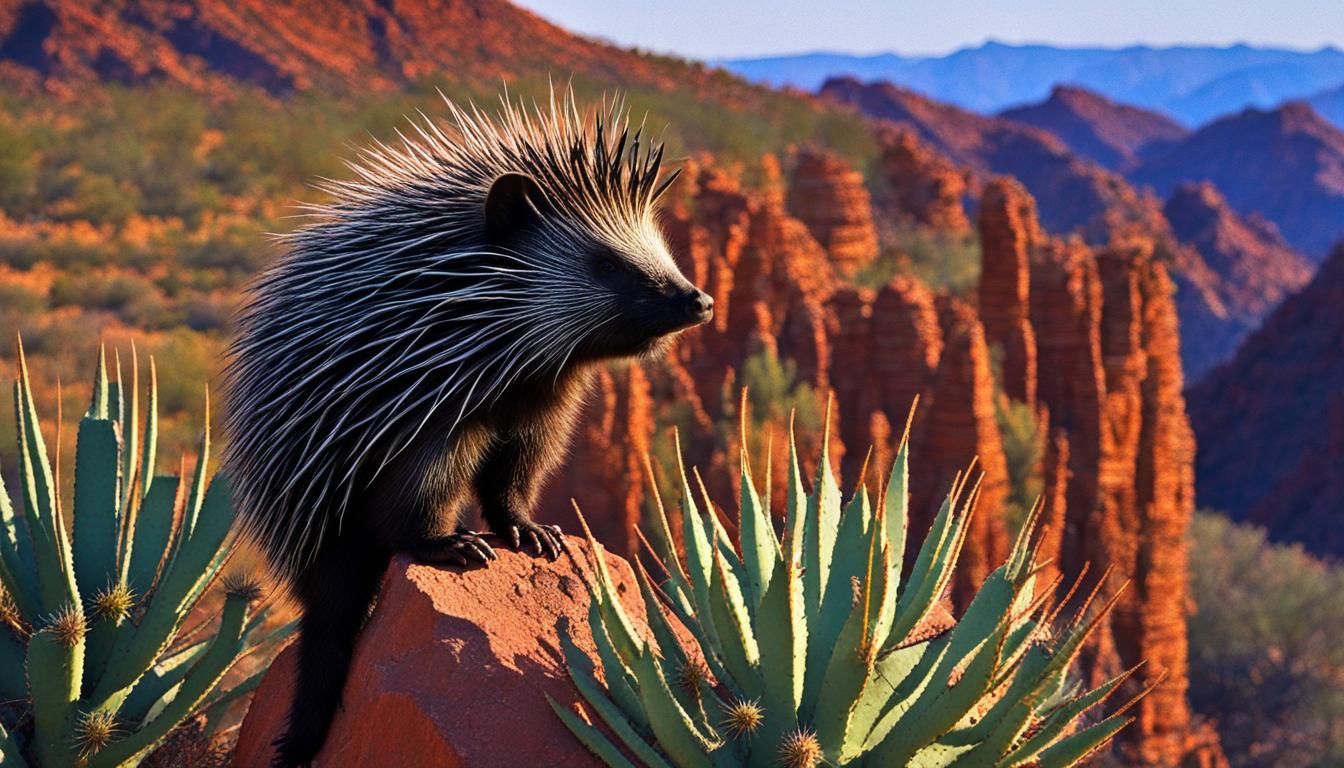Arizona is known for its diverse wildlife, but have you ever wondered if porcupines are found in this southwestern state? Let’s dive into the topic and unravel the truth about the presence of porcupines in Arizona.
Key Takeaways:
- Porcupines can be found in various habitats throughout Arizona, particularly in the northern parts of the state with abundant vegetation and trees.
- While sightings may not be common, localized populations of porcupines exist in forests and woodlands.
- Porcupines are herbivores that primarily feed on tree bark, twigs, and leaves.
- Conservation efforts aim to protect suitable habitat for porcupines and raise awareness about their ecological importance.
- If you encounter a porcupine in the wild, maintain a safe distance to avoid provoking the animal.
The Habitat of Porcupines in Arizona
Porcupines, fascinating creatures known for their quills, can indeed be found in various habitats throughout Arizona. While they may not be as commonly encountered as some other wildlife species, they do have a presence in the state.
Porcupines are most commonly found in the northern parts of Arizona, where there is a greater abundance of vegetation and trees.
The preferred habitat for porcupines includes forests, woodlands, and areas with dense vegetation. These areas provide them with ample food sources and suitable nesting sites.
Different species of porcupines, such as the North American porcupine, may inhabit different regions of Arizona based on their specific habitat requirements.
Overall, the habitat of porcupines in Arizona is characterized by forests and woodlands, where these unique creatures can thrive in the presence of abundant vegetation and suitable shelter.
Porcupine Species in Arizona
There are different species of porcupines that can be found in Arizona, with the North American porcupine being the most common.
These porcupines have a distinctive appearance, with their quills covering their body as a defense mechanism against potential predators.
The North American porcupine is a large, slow-moving mammal that primarily feeds on tree bark, twigs, and leaves.
Their strong claws and prehensile tail enable them to climb trees and navigate their habitat with ease.
This species of porcupine is well-adapted to the forests and woodlands of Arizona, where they can find suitable food sources and shelter.
While the North American porcupine is the most prevalent species in Arizona, there may be other porcupine species present in the state as well.
Further research and study are needed to fully understand the diversity of porcupine species in Arizona.
Porcupines Distribution in Arizona
While porcupines are not as commonly seen in Arizona compared to other wildlife species, there have been reported sightings of porcupines in various parts of the state.
These sightings suggest that porcupines have a presence in Arizona, although their distribution may be patchy and localized.
Porcupines are more likely to be encountered in areas with suitable habitat, such as forests and woodlands.
The northern parts of the state, where there is a greater abundance of vegetation and trees, are known to have a higher concentration of porcupines.
However, it is important to note that porcupines may also inhabit other regions of Arizona, depending on the species.
Patchy Distribution in Specific Regions
Due to their specific habitat requirements, porcupines may have a patchy distribution within Arizona.
Localized populations may exist in specific regions where the conditions are suitable for their survival. These regions are typically characterized by dense vegetation, including forests and woodlands.
It is important for researchers and conservationists to continue studying porcupine distribution in order to better understand their population dynamics and ensure their protection.
Porcupine sightings in Arizona provide valuable insights into their presence and distribution in the state.
By documenting these sightings, researchers can gather data on the range and habitat preferences of porcupines, which can inform conservation efforts.
Additionally, individuals who spend time in forests, woodlands, and other suitable habitats can contribute to our understanding of porcupine distribution by reporting any sightings they may have.
Porcupine Facts in Arizona

Porcupines in Arizona are fascinating creatures with unique characteristics and adaptations. These herbivores primarily feed on tree bark, twigs, and leaves, making them essential for maintaining the balance of the ecosystem.
They are known for their defensive quills, which can be raised when they feel threatened.
One interesting fact about porcupines is their ability to climb trees using their strong claws and prehensile tail.
This allows them to access food sources and seek shelter in elevated areas. Due to their climbing skills, porcupines are most commonly found in forests, woodlands, and areas with dense vegetation in Arizona.
Adaptive Quills
The quills of porcupines are what make them unique and easily recognizable. These quills are modified hairs with sharp barbs at the tip.
When a porcupine feels threatened, it can raise and rattle its quills as a warning sign. If provoked further, the porcupine can release its quills, which become embedded in the predator’s skin upon contact.
This defense mechanism helps porcupines protect themselves from potential predators.
While porcupines may not be as commonly encountered as other wildlife species in Arizona, their presence is significant.
By appreciating their role in the ecosystem and respecting their space, we can ensure the well-being of both humans and these fascinating creatures.
Porcupines in Arizona: Research and Conservation Efforts

Research on porcupines in Arizona is a crucial aspect of understanding these fascinating creatures and their role in the state’s ecosystem.
Scientists and conservationists are actively studying porcupines to gain insights into their behavior, habitat preferences, and population dynamics.
By collecting data and conducting field observations, we can better protect and conserve these unique animals.
One area of porcupine research in Arizona focuses on their habitat requirements. Scientists are studying the specific vegetation types and environmental factors that influence porcupine distribution.
This information helps identify critical areas for conservation and management, ensuring that suitable habitat is preserved for porcupines to thrive.
The Arizona Game and Fish Department and local conservation organizations play a significant role in porcupine research and conservation efforts.
Through collaboration and partnerships, these organizations conduct surveys, monitor populations, and implement strategies to protect porcupines and their habitat.
Conservation efforts for porcupines in Arizona also involve raising awareness about their importance to the ecosystem.
Education programs, public outreach, and community engagement initiatives aim to foster appreciation and understanding of these unique animals.
By promoting coexistence and responsible wildlife practices, we can ensure the long-term survival of porcupines in Arizona.
Overall, ongoing research on porcupines in Arizona, coupled with dedicated conservation efforts, is essential for the preservation of these intriguing creatures.
By understanding their needs, habitat requirements, and population dynamics, we can work towards a future where porcupines continue to thrive amidst the diverse wildlife of Arizona.
Porcupine Sightings and Encounters in Arizona

While porcupines may not be commonly encountered in Arizona, there have been reported sightings of these elusive creatures throughout the state.
People who spend time in forests, woodlands, and other suitable habitats may have a higher chance of spotting a porcupine. It is always exciting to come across one of these unique animals in the wild.
Porcupines are known for their distinctive appearance. With their quills raised, they can be quite a sight to behold.
If you happen to spot a porcupine, it is important to observe from a safe distance and avoid provoking the animal.
Porcupines are generally docile creatures, but they can become defensive if they feel threatened.
Protective Quills
Porcupines have a remarkable defense mechanism – their quills. These hollow quills are modified hairs that cover their bodies and serve as a deterrent to potential predators.
When a porcupine feels threatened, it can raise its quills, making it look larger and more intimidating. The quills are designed to detach easily and become embedded in the predator’s skin, causing pain and discomfort.
If you come across a porcupine in the wild, it is important to appreciate them from a safe distance and avoid any attempts to touch or handle them.
The quills can cause injury if they come into contact with human skin or a pet’s paws. By respecting their space and practicing wildlife safety, we can ensure the well-being of both humans and porcupines.
Porcupine Safety and Awareness in Arizona

When it comes to encountering porcupines in Arizona, it’s essential to prioritize safety and awareness.
While these fascinating creatures are generally docile, they can become defensive if they feel threatened.
By practicing responsible behavior and respecting their space, we can ensure both human and porcupine well-being.
If you happen to come across a porcupine in the wild, it is important to maintain a safe distance. Avoid approaching or attempting to touch them, as their quills can cause injury.
Admire these unique creatures from afar and observe their natural behaviors without disrupting their habitat.
Promoting Wildlife Safety
To promote wildlife safety and minimize potential conflicts, it is crucial to educate ourselves and others about porcupines and their behaviors.
Understanding that they primarily feed on tree bark, twigs, and leaves can help us avoid inadvertently attracting them to human-populated areas.
Coexisting with Porcupines
By respecting porcupines’ natural habitats and avoiding direct interactions, we can coexist peacefully. It is also important to teach children and visitors about porcupine safety and what to do if they encounter one.
Encouraging responsible wildlife observation and photography practices can help prevent stressful situations for both humans and porcupines.
Remember, when it comes to porcupines, it’s better to admire from a distance and appreciate the role they play in Arizona’s rich ecosystem.
Together, we can ensure their continued presence and contribute to the conservation of these remarkable creatures.
Conclusion
In conclusion, porcupines do exist in certain regions of Arizona, although they may not be as commonly seen as other wildlife species.
These fascinating creatures prefer habitats such as forests and woodlands, where they can find ample vegetation to feed on.
While encounters with porcupines are not frequent, sightings have been reported by individuals who spend time in these areas.
Porcupines in Arizona possess unique adaptations that make them well-suited for their environment.
Their strong claws and prehensile tails allow them to climb trees effortlessly, while their defensive quills serve as a deterrent to potential predators.
It is essential to practice wildlife safety and awareness when encountering porcupines in Arizona. Maintaining a safe distance and avoiding any interactions with these animals is crucial.
By respecting their space, we can coexist with porcupines and appreciate the important role they play in Arizona’s ecosystem.
FAQ
Are porcupines found in Arizona?
Yes, porcupines can be found in various habitats throughout Arizona, particularly in the northern parts of the state where there is a greater abundance of vegetation and trees.
Where are porcupines commonly found in Arizona?
Porcupines are most commonly found in forests, woodlands, and areas with dense vegetation in northern parts of Arizona.
How frequently are porcupine sightings reported in Arizona?
While not as commonly seen as other wildlife species, there have been reported sightings of porcupines in various parts of Arizona.
What do porcupines eat in Arizona?
Porcupines in Arizona primarily feed on tree bark, twigs, and leaves as they are herbivores.
What are some interesting facts about porcupines in Arizona?
Porcupines in Arizona have the ability to climb trees using their strong claws and prehensile tail. They are also known for their defensive quills that they raise when threatened.
What research and conservation efforts are being done for porcupines in Arizona?
Ongoing research is being conducted to study the behavior, habitat preferences, and population dynamics of porcupines in Arizona. Conservation efforts aim to preserve suitable habitat and promote awareness about their ecological importance.
How can I safely observe a porcupine in the wild?
If you come across a porcupine in the wild, it is important to observe from a safe distance and avoid provoking the animal. Do not approach or attempt to touch a porcupine, as their quills can cause injury.
Can porcupines be dangerous to humans in Arizona?
Porcupines are generally docile animals, but they can become defensive if they feel threatened. It is important to maintain a safe distance and avoid any potential interactions to ensure the well-being of both humans and porcupines.




